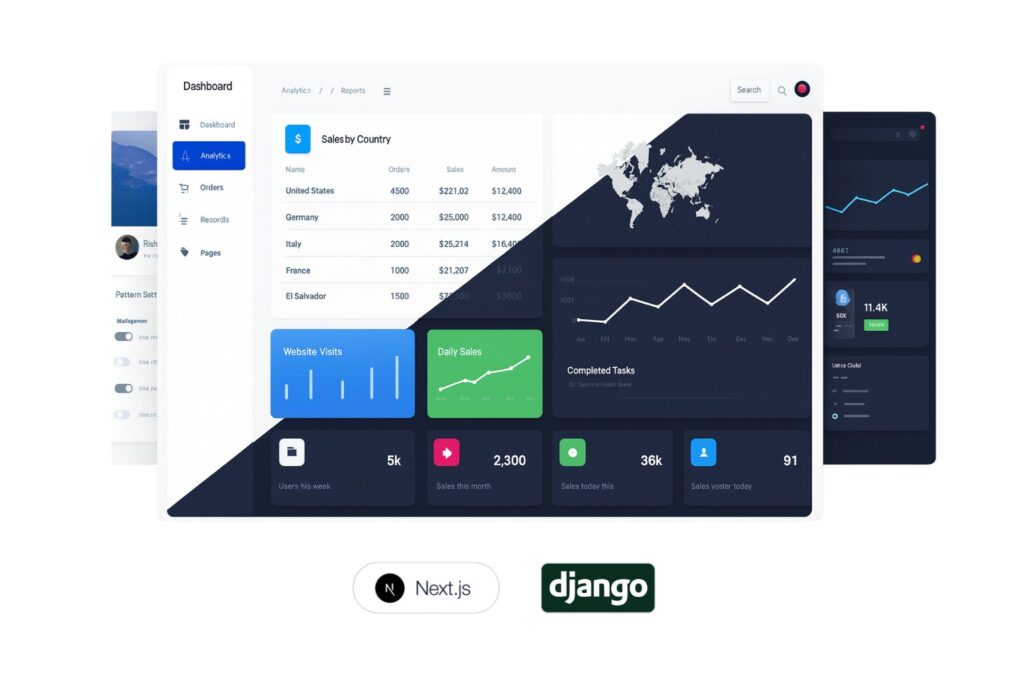Case Study
Home » SaaS Analytics Dashboard Using Next.js and Django
SaaS Analytics Dashboard Using Next.js and Django
Problem Statement
The client, a B2B SaaS company, struggled with fragmented data sources, manual reporting, and lack of real-time insights. Their legacy system was inefficient, error-prone, and not scalable for multi-tenant use. Users were dependent on Excel sheets and static tools to analyze campaign data, leading to slow decision-making, limited visibility, and a poor user experience.

Challenge
Data Integration
Consolidating data from APIs, databases, and CSV files without data loss or lag.Real-Time Performance
Visualizing real-time metrics (e.g., user sessions, conversions) without compromising performance.Security & Multi-Tenancy
Ensuring proper user-level data segregation and secure access management.User Experience
Designing an intuitive, mobile-friendly interface with drag-and-drop dashboards.Scalability
Building an infrastructure that could handle spikes in traffic and growing data volume without crashing or lagging.
Solution Provided
To meet all functional and technical requirements, we proposed a modern full-stack solution using Next.js for frontend rendering and Django REST Framework on the backend. Here’s how we approached the solution:
Frontend: We chose Next.js for its built-in support for server-side rendering (SSR) and static site generation (SSG), ensuring lightning-fast page loads. We built a React-based dashboard interface with Tailwind CSS and Chart.js for modular and responsive data visualizations.
Backend: Django provided a robust backend framework, and we implemented REST APIs for data fetching. Celery with Redis was used for asynchronous background tasks such as data synchronization and heavy computations.
Database & Storage: PostgreSQL served as the primary relational database. Each tenant’s data was isolated using Django’s built-in tenant management features.
Authentication: Used JWT (JSON Web Tokens) for secure, stateless user authentication and role-based access.
Development Steps

Data Collection
Integrated multiple third-party APIs (Google Analytics, Stripe, CRM tools) and internal databases to gather campaign, billing, and user engagement data.

Preprocessing
Cleaned and normalized data to ensure consistency across different sources. Handled missing values, standardized formats, and prepared data pipelines using Django ORM and Celery.

Model Development
Built backend logic in Django to compute metrics (KPIs, user behavior patterns, retention cohorts) and developed custom APIs for secure, multi-tenant data access.

Validation
Tested output accuracy by comparing dashboard metrics with original data sources. Used dummy data for unit tests and real-time data for integration testing.

Deployment
Deployed the solution on AWS using Docker and PostgreSQL. Utilized Vercel for hosting the Next.js frontend and Elastic Beanstalk for the Django backend.

Continuous Monitoring & Improvement
Implemented logging, alerting, and performance monitoring with tools like Sentry and Prometheus. Regularly gathered user feedback for UI/UX improvements.
Results

40% Reduction in Manual Reporting Efforts
The new dashboard automated all key reports, freeing up analyst time and reducing manual error risk.

Real-Time Analytics Across Sources
Real-time sync with tools like Google Analytics and Mailchimp enabled instant access to campaign and user metrics.

80% Faster Page Load Times
Server-side rendering with Next.js and optimized queries led to a near-instant user experience.

10+ Clients Onboarded in 3 Months
The multi-tenant structure made it easy to provision new clients, boosting product adoption and recurring revenue.

Increased Customer Retention by 25%
The dashboard became a competitive advantage, increasing user engagement and product stickiness.